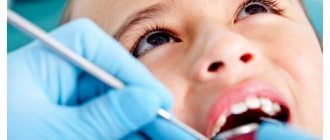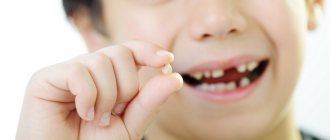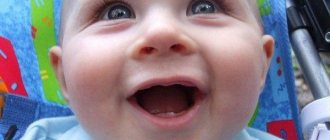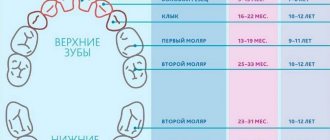Children's teeth appear in a certain sequence and in pairs (for example, two central incisors or two canines). But often the timing of teething in children shifts upward: many parents begin to worry and get nervous, but this is not worth doing, since the deviation from the norm is explained by the individual characteristics of the body, the uncharacteristic course of pregnancy, or various injuries received during childbirth.
Teething in children and features of this process
Quite often, a few weeks before the appearance of a baby or molar tooth, a lump filled with a clear or bluish liquid forms on the gum. Naturally, it worries parents, but there is no pathology in this formation, and the lump, which does not look very aesthetically pleasing, does not indicate the beginning of the inflammatory process. In most cases, no intervention by a doctor is required. You can contact the dentist if the lump increases in size: the doctor will make a small incision and release the liquid.
Baby teeth in children: order of eruption
Any newborn baby has follicles of milk teeth (20 pieces) and molars (16 pieces) inside the jaws. The remaining 16 rudiments will form later.
Teething in infants begins with the lower jaw: first the central incisors appear (6-10 months of the child’s life), then the canines (10-13 months), then comes the turn of the first (14-18 months) and second (17-23 months) molars .
Emerging teeth differ from adult teeth in having low-mineralized enamel. If you do not maintain oral hygiene, caries may begin to develop. In addition to careful adherence to hygiene rules, special gels and ointments that significantly accelerate the mineralization process will help make teeth stronger and more resistant to pathogenic microorganisms.
Can a baby cut teeth at such an early age?
The average time for teeth to appear in infants is 6–8 months. The first to grow are the two lower central incisors, which usually erupt one after the other. But you should understand that the time frame is not limited. Sometimes the process may take some time. There are cases when the first incisors appear earlier. Therefore, when asked whether teeth can be cut at two months, experts answer in the affirmative. A deviation of the time frame by several months in both directions is considered normal. Only if a one-year-old child does not have a single tooth should you consult a doctor.
Each organism is individual, so some babies already have their first tooth at 2–3 months. The process is determined not only by genetics, but also by a number of other factors:
- climatic conditions;
- maternal nutrition;
- features of the course of pregnancy;
- disruptions of the endocrine system - sometimes the early appearance of teeth may indicate its abnormalities.
If during pregnancy the mother took multivitamins or additional mineral complexes containing vitamins D and C, then the timing of teething may accelerate. A woman’s consumption of fermented milk products in large quantities also contributes to this.
Approximate timing of eruption of permanent teeth
The first of the molar permanent teeth to appear are molars (at the 6th year of life), located at the end of the dentition. But it is they who are most susceptible to caries, since there are deep depressions on their surface where bacteria accumulate due to poor cleaning and neglect of flossing.
The second molar appears 4-6 years later, when the child reaches 11-13 years of age. Incisors erupt at 6-8 years of a person’s life, canines - after 9 years of age.
Like newly emerged milk teeth, permanent teeth contain few minerals (a tenth of their amount in a mature adult). It is for this reason that it is important to teach a child proper hygiene. It wouldn’t hurt to treat your teeth with gels containing a large amount of fluoride once a quarter.
What time do teeth appear?
- Two incisors grow above and below in the middle of the jaw.
- Then, closer to the year, the neighboring four lateral incisors appear.
- Molars are the first to erupt before one and a half years of age.
- Afterwards, fangs appear above and below, on average from one and a half to two and a half years.
- The eruption of baby teeth ends with the appearance of second molars up to three years of age.
Photos of babies' first teeth will help inexperienced parents figure out what certain baby teeth look like.
Teething in children: symptoms
The first signs of the imminent appearance of teeth appear about a week before their appearance. The symptoms will not stop until the tooth breaks through the gum lining.
Signs of teething in a baby are as follows:
- the child becomes irritable for no reason;
- sleep deteriorates (if the child cries at night and tosses and turns, there is no need to immediately start rocking him to sleep - it is better to give the baby the opportunity to calm down on his own);
- the gums become very swollen and swell at the site where the tooth appears;
- the appetite deteriorates, the baby may even refuse to eat altogether, feeling hungry;
- the child begins to chew on various objects to relieve severe itching in the gums;
- salivation increases;
- Due to drooling, a rash may appear around the mouth, chin and chest.
There are also additional ones, i.e. optional symptoms of teething in infants:
- heat. If the temperature has increased, this most likely indicates an inflammatory process that develops in parallel with teething and is in no way connected with it (it could be stomatitis or any cold).
When the temperature rises, you need to carefully examine the oral mucosa. If there are small bubbles filled with a cloudy liquid, erosion, and the gums themselves are bright red, then the child has herpetic stomatitis. Any baby receives antibodies to the herpes virus from its mother, but usually by the time the first teeth appear, their effect ends. Often the catalyzing factor in the development of stomatitis is trauma to the mucous membrane, which is inevitable when teeth appear. If the above signs cannot be detected, then it is recommended to give the baby Panadol (suppositories are the preferred form of medication). As practice shows, it is useless to call a pediatrician, since this is not their specialization. Only a dentist can determine the specific type of stomatitis (aphthous, herpetic, etc.).
- hematomas on the gums. Sometimes the gums become swollen, turning an eerie shade of blue. Despite their frightening appearance, hematomas do not require treatment. Doctor intervention is allowed only for large hematomas that do not decrease over a long time.
- vomit. The only acceptable cause of vomiting is excess saliva entering the stomach and esophagus. If vomiting begins against the background of elevated temperature and, especially, diarrhea, then these symptoms have nothing to do with teething - you need to call a doctor.
- coughing is not a natural cause when teeth appear, unless the child has swallowed saliva that has entered the respiratory tract.
- A runny nose is a sign of a cold, not teething.
about teeth (detailed article + photos)
It is very difficult to explain in words HOW a tooth is cut. I wanted to find a photo report on the Internet and was surprised - no!!! I found a couple of photos of what the process looks like
in photo 2 you can clearly see what the tooth looks like when it is already on its way, etc. how the head of another tooth erupts. Photo 1 also shows a partially erupted head. At first the gums swell, turn red, partially turn pale, and then, as in photo 3, the gums bleed a little and tear.
If I had a camera, I would make a photo report, but in the absence of that, at least this way)))
article about teeth
Teeth are being cut. Timing of teething in children: when and how long?
The timing of teething can characterize both the biological and passport age of the child. The process and timing of teething depend not only on inherited genetic parameters, that is, how they erupted in mom and dad, and even in ancestors in the seventh generation. The timing of teething can be influenced by external and internal factors. For example: climatic conditions, diet, quality of drinking water, etc. In this regard, the timing of the eruption of permanent teeth in children varies in different regions. The hotter the climate, the earlier teething usually occurs. Although this is also not an axiom.
Baby teeth usually begin to emerge at 6-8 months. A one-year-old baby, as a rule, celebrates his first birthday with four upper and lower incisors in his mouth. By the age of two, the first primary molars and canines erupt. Second primary molars appear after another six months. Complete formation of the primary dentition is usually completed at three years of age. By the age of three, a child should have grown all 20 baby teeth.
What to do if by 9 months your child has not yet erupted a single tooth? First of all, don’t worry ahead of time. Dentists consider a delay in the eruption of primary teeth within 6 months to be completely natural. However, boys tend to erupt teeth later than girls.
Start by carefully examining your baby’s gums: it is very likely that they look swollen and reddened, or, on the contrary, the gums are thin and pale, and the edge of the tooth can be felt underneath and even visible. In order to speed up teething, buy special ring toys - teething stimulators. A light massage of the gums with a clean finger is also useful. Pressure on the gums facilitates and speeds up teething, and cold reduces discomfort.
Delays in teething can be caused by general growth retardation due to a number of child diseases, primarily rickets. Consult your pediatrician: your baby may need vitamins or calcium supplements to maintain normal mineral metabolism.
In rare cases, children have edentia - the absence of tooth buds. So if your baby is over a year old and his teeth have not yet begun to emerge, you should consult a dentist. You can check the presence of tooth germs using an x-ray. X-ray irradiation may be unsafe for a child’s body, so this study should be performed only when necessary and as prescribed by a doctor. Today it is possible to reduce the harmful effects of X-rays if you take a picture using a radiovisiograph. Such equipment is usually available in every modernly equipped dental clinic. Symptoms of teething in a child.
How to determine that a child is already cutting his first tooth? Symptoms of a baby's first teeth erupting include red, inflamed gums, burning cheeks and, possibly, an already swollen white ball from which a tooth is about to emerge. True, he can make himself wait. Before being exposed, the tooth must first pass through the bone tissue that surrounds it, and then through the mucous membrane of the gums.
Is it necessary to somehow help teething? You should not interfere with the natural course of events, because nature has provided that children’s teeth are born independently, without special external efforts or additional devices. There is no need to irritate your baby's gums by scratching them with a piece of sugar or the handle of a spoon, as was done before. This can damage delicate baby teeth and cause infection in the jaw bone. Be careful with bagels, bread crusts, bagels: their crumbs can get stuck in the respiratory tract.
During a person’s life, 20 teeth change once, and the remaining 12 teeth do not change; they erupt initially as permanent teeth (molars).
Teething. First (medial) lower incisors - 6-9 months. First (medial) upper incisors - 7-10 months. Second (lateral) upper incisors - 9-12 months. Second (lateral) lower incisors - 9-12 months. First upper molars - 12-18 months. First lower molars - 13-19 months. Upper canines - 16-20 months. Lower canines - 17-22 months. Second lower molars - 20-33 months. Second upper molars - 24-36 months.
These tables are approximate. According to statistics, the first tooth in modern infants appears on average only at 8 and a half months. Thus, the timing of the eruption of other teeth is shifted. Dentists believe that the later the first tooth erupts, the later the baby teeth will begin to fall out and this is undoubtedly good. However, before the baby is one year old, at least one tooth must appear, otherwise the causes should be looked for in some diseases, for example, rickets. The first tooth can be paired with the second, and the same is true with subsequent teeth. It happens that a baby has 4 teeth at once. Naturally, such “massive” growth of teeth affects the timing of teething. The situation is also uncertain with the order in which teeth appear; you simply cannot influence this, so “don’t worry in vain,” because everything goes as nature intended.
By the age of three, all baby teeth erupt in a child, which by the age of 5 begin to gradually be replaced by permanent ones.
There are 20 primary teeth in total: on each jaw there are 4 incisors (4 central teeth), 2 canines (third teeth) and 4 molars (fourth and fifth teeth).
By the age of 10-12 years there are 28 teeth.
An adult normally has 28-32 permanent teeth: each jaw has 4 incisors, 2 canines, 4 premolars and 4-6 molars. The development of the third molar (“wisdom tooth”) may not occur at all, with congenital edentia of the third molars, which is also considered normal. Another situation is also possible: a wisdom tooth is embedded in the thickness of the jaw, but does not erupt due to incorrect position or lack of space in the jaw. This situation occurs very often.
After all the baby teeth have erupted, there are no gaps (gaps, gaps) between them, which is normal. But as the jaw grows, before the baby teeth are replaced by permanent ones, gaps should appear between the baby teeth. This process is necessary because permanent teeth are larger in size than baby teeth and if spaces are not formed, then the permanent teeth do not fit in the jaws and the child receives “crooked” permanent teeth.
In parallel with the formation of spaces between temporary teeth, the roots of baby teeth are “reabsorbed”, after which the teeth alternately become loose and fall out. Nowadays there is even a fashion to buy a box made of gold or silver to store the first teeth.
There is no general opinion about the normal timing of teething, since scientific studies by different authors were carried out in different regions and in different years of the last and present century. The child is teething. If it hurts a lot...
Teething may be accompanied by increased excitability: the child becomes restless, capricious, often wakes up crying at night, and may refuse to eat. At the same time, the baby puts any object in his mouth, since chewing reduces the itching of irritated gums. The secretion of saliva is sharply increased, which, flowing from the mouth, can cause skin irritation. Often, a limited area of redness or rash appears on the cheek on the side of the erupting tooth. The child's temperature may rise to subfebrile levels (within 37.8°). However, fever does not necessarily accompany teething.
During teething, one or another infection may develop. Therefore, if your baby develops symptoms such as nausea, vomiting, ear pain, diarrhea, cough, rash, persistent loss of appetite or high fever, you should consult a doctor.
What remedies relieve pain? The simplest thing is cold. Cold relieves pain and reduces swelling. If this does not help, you can use dental gel or ointment containing anti-inflammatory and pain relievers to lubricate the gums. If necessary, you can give your child a pain reliever. Any medications should be used only as prescribed by a doctor. What to do if teeth erupt at the wrong time?
Nothing to do. There is no clear concept of “late teething”, or rather “teething dates” are relative, generally accepted terms, and not strict data. These terms are determined by average values and depend on neonatal (how the birth went) indicators, physical constitution, individual characteristics of the baby, etc. So, no matter what time teeth erupt, this period is normal for this child. By the way, the same applies to the eruption of permanent teeth and wisdom teeth. Only in rare cases of obvious pathologies can the timing of eruption really be abnormal. The later teeth erupt, the healthier they are?
Unfortunately, this is not the case - the timing of teething and their “quality” are in no way connected. What sedatives can be used in children during teething? Do these drugs affect the teething process?
No, these drugs do not affect the teething process in any way. They have all been clinically tested and naturally have no side effects. The only limitation is children with allergies, but there is also a sedative for them - Doctor Baby. Almost all such gels contain lidocaine and inert fillers (menthol for cooling, flavoring agents and astringents). The following drugs can be recommended:
Dentinox Kalgel is sweet and should not be used if you have diathesis. Kamistad is very effective, but must be used in moderation. Mundizal Cholisal “Solcoseryl” dental paste (available for external use, do not confuse it) – is especially effective if there are bleeding wounds or painful ulcers. Dr. Baby - for lidocaine allergies How often can soothing gels be used?
Soothing gels do not need to be used according to a specific regimen (such as antibiotics). If it hurts, you apply it, if it doesn’t hurt, don’t apply it. But don’t get too carried away, it’s better not to use it more than 3-4 times a day and more than 3 days in a row. How to speed up teething?
No medication. A method proven over the years is a gentle massage of the gums. Gently massage the gums with a clean finger and the child will feel better, and the tooth will erupt a little faster. Just don't press hard, don't injure yourself. Usually they give the child a cold spoon to suck on, but it is better to keep the pacifier in the refrigerator for a while and give it to the child. There are special teethers with coolant. Place in the refrigerator. Then you give it to the child to chew on. But not for long. Can bad breath occur during teething and what is the reason for this?
During teething, the mucous membrane partially decomposes (lysis). Salivary enzymes play an active role in this process. As you know, the amount of saliva increases during teething. This is due specifically to the lysis process. This can actually change the viscosity, color and smell of saliva. In addition, saliva contains weak antibacterial substances that prevent infection of the wound formed during tooth eruption. Their active influence can also change the normal properties of saliva. A certain amount of blood also enters the oral cavity, and when it decomposes, a sour (metallic) odor may also arise. What to do if the temperature rises sharply during teething?
A slight increase in temperature during teething is normal. But she won't be 39-40. If the temperature is very high, some kind of infection is to blame, and not the teeth themselves.. Attention: teething should not cause severe fever, diarrhea, vomiting, complete loss of appetite, cramps and suffocation. If you experience these symptoms, even if you think they are related to your teeth, consult your doctor. It is also not recommended to give a child an antipyretic and analgesic (syrup, suppositories) without consulting a doctor and when the body temperature is below 38.5 C. How can children distinguish between an increase in temperature during teething and an increase in temperature for some other reason? How long can a fever last during teething?
Everything is individual, but generally hyperthermia and diarrhea are only secondary signs of teething. For a very small organism, this is a severe physiological fracture. Now most pediatricians and physiologists admit that increased temperature during teething is most likely a reaction to inflammation of the oral mucosa. At the site where the teeth emerge, irritation forms, often a wound (from friction and due to lysis), and often the wound becomes infected. So the increase in temperature is not caused by the mechanism of tooth formation itself, but with complications. One of the arguments in favor of this opinion is that when permanent teeth erupt, despite the similarity of histological and physiological changes, such symptoms almost never occur.
The occurrence of cold and diarrhea symptoms is explained by a sharp change in diet and diet, constant foreign objects in the mouth and microflora disturbance, as well as a weakening of local immunity in the nasopharynx.
From this we can conclude that if the fever and loose stools continue for too long (more than 72 hours), then the reason most likely is not teething. Possible features of teeth in children at the teething stage:
Expansion of spaces between teeth. It may reflect increased jaw growth and during the transition period from baby teeth to permanent teeth is regarded as a normal condition. A wide gap between the front incisors on the upper jaw is usually associated with a deep-lying maxillary frenulum. The tactics for monitoring and treating wide gaps between teeth are determined by an orthodontist.
A blackish edging on the neck of the tooth can be due to the use of soluble iron preparations or a chronic inflammatory process (precipitation of bacteria of the leptotrichium group);
Yellowish-brown staining of teeth is most often associated with the use of antibiotics by the mother in the second half of pregnancy or by the child during the period of teeth formation.
A yellowish-greenish color develops in severe disorders of bilirubin metabolism and hemolytic (destruction of red blood cells) conditions;
Reddish staining of tooth enamel is characteristic of a congenital disorder of pigment metabolism - porphyrin. This disease is called porphyria;
Malocclusions occur due to uneven growth of the jaws, due to prolonged sucking of the nipple; Anomalies in the location of teeth occur for constitutional reasons (small jaw size), due to trauma, congenital disorders of connective tissue metabolism, and tumors of the alveolar process of the jaw.
The absence of teeth before 1 year of age is extremely rarely associated with edentia - the absence of their rudiments. You can check the presence of tooth germs using a special radiovisiography method prescribed by a pediatric dentist. Atypical situations during teething in a child
Timely growth of teeth in a certain sequence indicates the normal development of the baby’s body. This is a physiological process and is directly related to the general health of the child. But let’s consider some atypical situations that may indirectly indicate the presence of pathology. However, only indirectly. Let us make a reservation once again that only careful research can confirm or refute these assumptions.
1) A delay in the timing of eruption (longer than 1-2 months from the norm) may be a consequence of rickets, an infectious disease, prolonged dysfunction of the intestines and changes in metabolism. 2) Earlier teething (before 1-2 months before normal) may indicate endocrine disorders. 3) Violation of the order, the absence of one or another tooth can also be the result of some anomalies in the child’s health (there are isolated cases when even the rudiments of teeth are missing) or be a consequence of diseases suffered by the mother during pregnancy. 4) The eruption of a tooth outside the arch of the dentition can be caused by an incorrect position of the tooth axis (horizontal or oblique). 5) Incorrect formation of the tooth itself - size, shape, position, color, lack of enamel coating, etc. The causes of these phenomena should be analyzed by a specialist. 6) The appearance of teeth even before birth. Such situations are extremely rare. Such teeth prevent the baby from sucking at the mother's breast; they are usually removed. Here are some things to remember when teething:
Regularly rub your baby's face with a special towel to remove saliva and prevent skin irritation; it is better not to rub, but to gently blot the saliva so as not to cause irritation around the mouth. Place a clean, flat cloth under the baby's head to absorb any drool. When the napkin gets wet, you won't have to re-make the sheet.
Give your child something to chew on. Make sure the item is large enough that your child won't swallow it or chew it into small pieces. A damp washcloth placed in the freezer for 30 minutes can be a good solution, just remember to wash it after each use. Special teething rings, which are sold in pharmacies, are also effective. If you are using rings, do not freeze them until they turn to stone to avoid damaging your weak gums. Never tie a teething ring around your baby's neck to avoid getting caught in the band. Gently massage your baby's gums with a clean finger.
Never put aspirin or other tablets on your teeth, or rub alcohol-containing solutions into your gums. If your child is not feeling well, paracetamol in pediatric dosage may help. BUT FIRST CONSULT YOUR DOCTOR!
When teeth appear, you need to start caring for them. A child up to 1-1.5 years old can brush his teeth once a day with a special soft plastic brush (put on the mother’s finger). In this case, it is convenient to sit the baby on your lap, with his back to you. For an older child, you can buy the first children's toothbrush of a comfortable size, with durable bristles. At this age, children imitate adults with pleasure, and the ritual of morning and evening brushing of teeth is easily established. It is clear that the baby is still playing with brushing his teeth, and while the mother is brushing them - it is most convenient to stand behind the baby in front of the mirror. From the age of two, you can teach your child to rinse his mouth with water (it would be good to do this every time after eating) and use children's toothpaste. You may have to try several brands of toothpaste before your baby is satisfied with the new taste.
Other measures to prevent caries (baby teeth are more fragile than permanent teeth and are affected in a shorter time!) include monitoring the amount of sweets in the child’s diet and avoiding sweet drinks (juices, sweet water) at night and at night.
Your child should see the dentist for the first time when he or she is one year old. However, if you are worried about something - irregular teething, darkening of the tooth, stains on it, bad breath - consult a doctor as soon as possible. The health of baby teeth is the key to the proper formation and health of permanent teeth. How to prevent tooth decay
1. Do not lick the pacifier or use a baby spoon to taste your baby's food. This will protect your baby's mouth from bacteria found in an adult's saliva. 2. If possible, reduce the sugar content in your child's diet. Offer water or natural juice instead of sweetened drinks, and never give sugary drinks as a sleep aid at night. 3. Teach your one-year-old baby to drink a few sips of water after eating, and after two years - to rinse his mouth after eating. 4. Bring your child to the dentist regularly for examinations. The first time this can be done is two years old. If problems arise earlier, do not delay going to the doctor. Check your child's teeth at least once every six months. 5. Try to prevent dental injuries. If the enamel is damaged, they are destroyed faster. Strengthen your baby's teeth with a healthy menu. Include in your child's daily diet 10 - 20 g of hard cheese, a few tablespoons of seaweed, 5 - 6 raisins, 1 - 2 dried apricots, green and black tea (rich in fluoride). 6. The child should brush his teeth after every meal or at least twice a day, including always before bed. Have you cut your teeth? It's time to clean
Immediately after teething, the child’s teeth are exposed to aggressive environmental influences. Microbes settle on the teeth, forming a film of plaque. Acids are actively produced in dental plaque. Under their influence, the enamel of baby teeth is easily destroyed and a carious cavity is formed.
Acid production occurs especially actively in the presence of sugar. Therefore, the cause of the development of caries in the first years of life is often an early transition to artificial feeding, especially if the child sucks sweet milk formulas or juices from a bottle for a long time.
You need to start regular oral care before teething. Using a moistened sanitary napkin placed on a clean finger, carefully wipe the mucous membrane of the cheeks and gums. Newly erupted incisors are also first wiped with a napkin.
In the second year of life, it is time to start using a toothbrush. Today there are special toothbrushes on sale - they are small and have especially soft bristles. For example, I can recommend the “My First Colgate” brush. Funny bright toys decorating the handle of this brush will form a positive attitude towards brushing your teeth in your child.
Until two years of age, we recommend that parents clean their baby’s teeth simply with a damp toothbrush. From the age of two you can start using toothpaste. It is best if it is a paste containing fluoride. However, it should be remembered that a small child tends to swallow toothpaste while brushing, so up to 6 years of age it is better to use children's toothpastes with a reduced fluoride content. For one-time brushing, it is enough to use a small amount of fluoride toothpaste - about the size of a pea.
The risk of early development of caries is increased with insufficient fluoride content in drinking water. This situation occurs, for example, in Moscow and St. Petersburg. Children from 2 to 14 years old need compensation for the daily intake of fluoride into the body. Your child's pediatrician or pediatric dentist should determine the recommended daily dose of sodium fluoride tablets or drops for your child.
Caring for children's teeth
The pattern of teething in children determines the approximate time of their appearance, but it is necessary to start observing oral hygiene as early as possible, without waiting for the teeth to erupt.
Breasts cannot take care of themselves, so they need help cleaning their gums. This is done either with the help of a fingertip, or, if there is none, with the help of an ordinary bandage dipped in warm boiled water and wound around the finger.
If teeth begin to erupt, you cannot do without the use of special products (baby pastes, brushes, etc.).
White spots on a child’s teeth: a simple defect or an alarming symptom
All parents want to see their child happy and healthy. Therefore, it is important to carefully monitor the condition of his body. For any alarming symptoms, a causative factor must be found. Attentive attention to oral health is one of the main conditions for ensuring good health for the baby. If you notice white spots on your child's teeth, there is no need to panic, but you should not let the problem take its course. More often it indicates the beginning of the development of caries, but it can also manifest itself for other reasons. The dentist will help you cope with the problem.
Types of teething disorders
Teething in children, the sequence of which is clearly defined, can occur with a delay caused by various reasons (illness of the mother during pregnancy, diseases suffered by the child, etc.). Due to the delay, deformation of the jaws may begin, because There is not enough free space for teeth that have not yet erupted. In this case, only the dentist can decide on treatment after a thorough visual examination of the child and analysis of the photograph taken.
The next very common disorder is enamel hypoplasia, which manifests itself in spots of different colors on newly emerging teeth, pits or grooves. Hypoplasia causes complications during pregnancy.
Individual characteristics of the appearance of teeth
It is worth noting that there is no single answer to the question of what time a baby’s first teeth begin to cut, since the development of a child as a whole is of a purely individual nature. But, on average, the appearance of teeth can be expected in the range of four to nine months.
This process is influenced by many factors. Among which:
- genetic predisposition and heredity for the appearance of teeth in a child
- living conditions of the baby - climate, nutrition
- compliance with the regime during the mother's pregnancy.
The gender of the child also influences. Doctors have noted that the appearance of the first teeth in girls occurs much earlier than in boys, which characterizes the general trends in the development of children.
Girls under one year of age develop more rapidly, begin to walk earlier and, sometimes, by this age they utter their first words.
Why do teeth erupt with irregularities?
The condition of a child’s teeth in the first years of life depends on the health of the mother during pregnancy. The formation of hard dental tissues may be disrupted if a woman:
- suffered from toxicosis at the initial stage of pregnancy;
- experienced severe prolonged stress;
- was treated for kidney disease;
- suffered from rubella.
In addition to maternal diseases, the maturation of teeth and the development of the jaw system can be affected by:
- fetal prematurity or, conversely, delayed birth;
- conflict of Rh factors;
- sepsis suffered by a child in the first month of life;
- frequent colds, pneumonia;
- convulsions;
- toxicosis;
- refusal to breastfeed.
Often, parents, driven by the best intentions, want to alleviate the baby’s suffering by giving him medications. You must understand that any medicine, even if it seems completely safe, cannot be taken without consulting a pediatrician!
Preventive measures
It is important to provide your child with proper dental care. Immediately after the first incisor appears on an infant, it is necessary to thoroughly clean it with a special brush-finger 2 times a day. It is necessary to ensure proper oral care even before teething begins. For this purpose, wipe the gums with a sterile piece of gauze soaked in boiled water. Other preventative measures:
- limiting the consumption of sweets, confectionery, carbohydrate foods, acidic foods and drinks;
- regularly visit the dentist with your child - at least 2 times a year, ideally - every 3-4 months;
- Give your baby vitamin complexes after illnesses and during periods of active growth - only as prescribed by the pediatrician.
It is important for the expectant mother to follow a diet and not take medications without the doctor’s approval.










